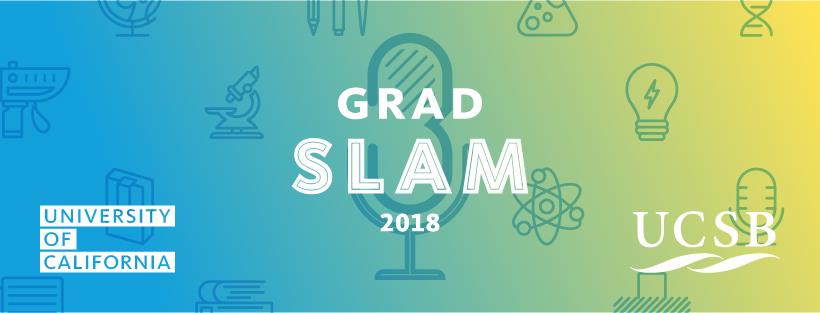Top Stories
The Grad Slam semifinals continue with round 3, Wednesday April 18. Join us to cheer on your fellow graduate students as they vie for a spot in the final round. Here's a preview of what's to come... be sure to follow us on Facebook for live updates on the winners of each round.

The Grad Slam semifinals continue with round 3 on ââWednesday, April 18. (View the full semifinal schedule here.) Join us to cheer on your fellow graduate students as they vie for a spot in the final round. Here's a preview of what's to come... be sure to follow us on Facebook for live updates on the winners of each round.
ROUND 3
Wed Apr 18 | 11a-12p
SRB Multipurpose Room
Audrey Abeyta | Communication
Where You At?: The Role of Geospatial Concordance in Assessments of Online Credibility
In an increasingly connected world, individuals can share information with others without regard for geographical distance; as a result, an individual's physical location is seeming less important than ever before. However, the results of our experiment indicate that individuals consider the geographic location of a reviewer when assessing the credibility of their online reviews.
David Grimsman | Electrical & Computer Engineering
Synergy with Strategy in Submodular Maximization
Computationally-intense problems are often solved or approximated in a distributed manner, where agents make local decisions that are aggregated to form a global solution. The quality of such a solution is dependent on the nature of collaboration among the agents. This work uses mathematical proof to show the optimal decision rule and "social network" structure among agents in optimizing functions that exhibit a diminishing returns property.
Erin Winslow | ââEnvironmental Science & Management
Coral Community Dynamics: A Mystery in Moorea, French Polynesia
Coral reefs around the world are experiencing mass bleaching events in response to global climate change and human impacts. Reef communities in Moorea, French Polynesia have not experienced dramatic bleaching, but the composition of coral taxa varies greatly around the island as reefs recover from disturbance. Why is this?
Gregory Gate | Chemistry
Evolution of Life in the Light
The code of life (DNA) evolved on an early Earth in face of abundant and energetic ultraviolet radiation. This UV bombardment was one of the driving factors in the selection of life's genetic material. The molecules of life were selectively chosen for their UV resistance, unlike structurally similar molecules.
Jasmine McBeath | Education
Community-Oriented Making: Engineering Change
Learn about best practices to engage STEM-underrepresented groups in making, the meaning of community-oriented making/engineering, and examples from our program blending STEM, art, and social action at a local teen center.
Lauren Menzer | âEnvironmental Science & Management
KINN: An Assessment of Apparel Toxin Impacts on Human and Environmental Health
The chemicals used in the apparel industry range from pesticides and formaldehyde, to synthetic dyes and flame retardants. Many of these chemicals are known carcinogens, endocrine disruptors, and skin irritants that can have immediate or latent negative effects on human health and the environment. Scientific research is has identified these endocrine active compounds as adversely affecting human hormonal systems, but many gaps still exist in knowing the connections between how toxins interact with one another and within the human body. Our research pieces together the various pathways that mothers and newborns are exposed to endocrine disrupting chemicals from the apparel industry, and the extent to which these toxins impact their immediate and long-term health systems.
Rebecca Baker | English
Cognitive Cyborgs: Minds, Machines, and (Re)Mediated Techno-Cultural Identities in the Post-Millennium
The Millennial generation, born into a period of human history experiencing unprecedented levels of technological and social change, is easy to malign. Though the popular view holds that this generation has "lost" certain capacities for being and knowing, this easy invective circumvents other salient questions, such as what it might mean for humans to be "born digital", and how scholarship and reading practices can evolve to reflect increasingly rhizomatic, non-binary views of reality, identity, and socio-political possibility. Beginning with Donna Haraway's foundational "Cyborg Manifesto" from 1985 and drawing on current trends in Cognitive Literary Studies, this talk will discuss and attempt to situate the figure of the Cyborg as a techno-biological trickster with that of the Millennial-a subjectivity that exists in the liminal space of both paradox and potentiality.
Tatum Katz | Ecology, Evolution & Marine Biology
Spatial Epidemiology for Salamanders
If we know how it spreads, maybe we can figure out how to stop it. Batrachochytrium salamandrivorans (Bsal) is a newly discovered, invasive pathogen that is lethal to many salamander species and is currently causing an epidemic in Europe. Through the use of ecological niche modeling and model selection we were able to validate current hypothesis about what drives Bsal spread in its non-native range. These insights can be used to inform management strategies aimed at halting pathogen spread and preventing local extinctions of salamanders in Europe.